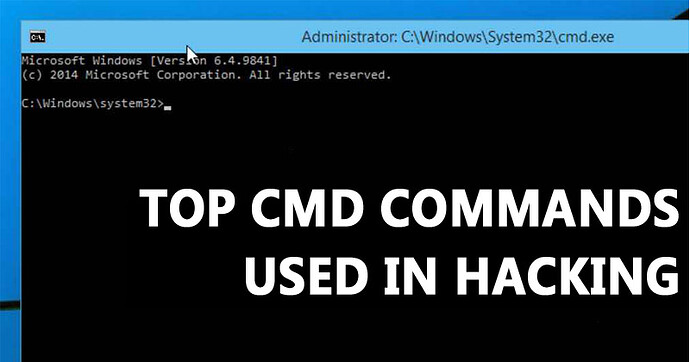10 Best CMD Commands Used In Hacking: If you are following 1Hack regularly, there are higher chances that you are a very versatile hacker in your own right and don’t feel the need to know these commands.
- Before we begin sharing the best cmd commands for hacking lets see how to enable the NetBios.
First, open your Network Connection and right click and select Properties . Then Select TCP/IP and click Properties again. Now Click on Advanced and WINS tab. Select Default for NetBIOS .
Now back to the main Local Area Connection window, select File and Print Sharing for Microsoft Networks and hit enter.
This is just to make sure you have NetBIOS enabled. We will have some fun with NetBIOS on CMD.
- In case you don’t know how to get CMD by clicking the Windows icon at the left-hand bottom of your screen in all Windows versions and click on
Start. Pressrunfrom the start, then type “cmd” without quotes.
A command prompt is really a powerful tool which lets you do almost everything with your PC/Laptop.
10 Best CMD Commands Used In Hacking
Here in this post, I am going to share few CMD commands that are used by hackers. I will list out the command and its use which will make sure you got the very minute details regarding the commands.
1) ping
ping command allows users to know if the host they are pinging is alive or not. With this command, you can know the amount of time it took to reach the specific address.
You can type in command prompt ping 8.8.8.8 which right now belongs to Google.
2) nslookup
nslookup command had the wide variety of functionalities. This is actually a network administration command line tool which will help you to get the domain name or IP address mapping for any specific DNS records.
For example, type in nslookup www.google.com on the command prompt and it will tell you the IP address.
3) tracert
The name of the command says it all. The tracert command will help you to trace the route that a packet will travel to reach its destination.
You can enter commands like tracert x.x.x.x. (x is the IP address here) or else you can type in the name like tracert www.google.com
4) arp
If you want to modify the ARP cache then ARP command will help you. This command is mostly used to find out if anyone has done arp poisoning into the LAN. you can use the command arp -a
5) route
Unlike tracert, the route command will show you everything in between what comes in the packet and its destination. It will show you the gateway, interface, routing table and metric.
To use this command type: route print
6) ipconfig
This is a common command and can be used by everyone who keeps less knowledge regarding computer’s core components. This command will list out the IP address, Gateway, DNS and much more.
You can try the code: ipconfig or ipconfig /all
7) netstat
The netstat command will help you to find out who is establishing a connection with your computer. You will get to know about the active connections and listening ports. To use this command, type netstat -a into the command prompt.
8) Net View
To use this command enter net view xxxx (IP address) or your computer name. This command will list out the entire list of resources, domains, and computers that are shared by the specified computer.
9) Net User
If you ever forgot your Windows login password, then you can utilize this command to reset Windows user password. You can also add new users or modify existing users using net user command.
However, the net user command is the little bit technical. So, for that, you can visit this link to know about how to use net user commands.
10) Net Use
This command is widely used to remove, connect and configure the connection on shared resources like printers, mapped drives, network printers and more. This command also needs technical knowledge. For that, you can visit this link.
Some additional CMD commands which will help you in hacking-
Code:
net use \ipaddressipc$ “” /user:administrator
(this command will allow you to connect to the target as administrator)
Now if you want to connect to the target and browse the entire C drive, then use this command:
Code:
net use K: \computernameC$
(this will create a virtual drive on your “my computer” folder)
Please note that this command will only work if the target PC/laptop has not set an Administrator Password.
And last but not least, the “help” command.
Quote:
whatevercommand /help
or
Quote:
whatevercommand /?
This command is very useful in finding what a particular command does, especially if you are a newbie.
Conclusion
So these were few of the best cmd hacks. Hope you liked it. If you have found any command other than those listed above, kindly note them in the comments for our other readers.
